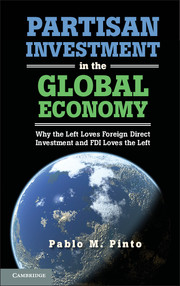 Partisan Investment in the Global Economy
Partisan Investment in the Global Economy Published online by Cambridge University Press: 05 March 2013
Introduction
In this chapter, I aim to assess the effect of the partisan alignments of the chief executive in the host country on the levels of inbound foreign direct investment (FDI) flows. I present the results from statistical analyses of the main hypotheses derived in Chapters 2 and 3. The statistical models build on a vast body of empirical literature in economics on the determinants of capital flows. The analysis establishes that when the conditions for investment are present, politics can have a sizable impact on investment flows. The driving political force in the host country reflects the expected distributive consequences of investment inflows. As I argue in Chapters 2 and 3, governments are likely to adopt investment regimes that benefit their core constituents and to abide by these policies over time. Pro-labor governments promote the well-being of workers and pro-business governments promote policies that benefit domestic capital owners. In the first stage of the analysis, I assess the external validity of one of the implications of this partisan hypothesis, namely the effect of partisanship on investment policy.
For this purpose, I develop a measure of investment policy orientation using data from OECD countries. There are numerous policy instruments, or political outcomes, that affect either the returns to capital or its form of entry, which is ultimately what FDI regimes target. Host governments may, among other initiatives, grant tax breaks and subsidies, regulate market structure, adjust trade policy, protect property rights, establish nationality and/or performance requirements, or create differential exchange rates in order to attract or deter the inflow of capital.
To save this book to your Kindle, first ensure [email protected] is added to your Approved Personal Document E-mail List under your Personal Document Settings on the Manage Your Content and Devices page of your Amazon account. Then enter the ‘name’ part of your Kindle email address below. Find out more about saving to your Kindle.
Note you can select to save to either the @free.kindle.com or @kindle.com variations. ‘@free.kindle.com’ emails are free but can only be saved to your device when it is connected to wi-fi. ‘@kindle.com’ emails can be delivered even when you are not connected to wi-fi, but note that service fees apply.
Find out more about the Kindle Personal Document Service.
To save content items to your account, please confirm that you agree to abide by our usage policies. If this is the first time you use this feature, you will be asked to authorise Cambridge Core to connect with your account. Find out more about saving content to Dropbox.
To save content items to your account, please confirm that you agree to abide by our usage policies. If this is the first time you use this feature, you will be asked to authorise Cambridge Core to connect with your account. Find out more about saving content to Google Drive.